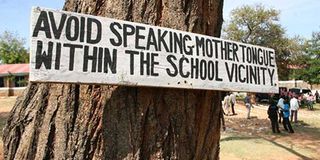Why local languages are crucial in learning

A signboard pinned on a tree at Sangach Primary School in Marakwet East discouraging pupils from speaking mother tongue. Many school going children continue to be taught in languages they neither use nor understand. PHOTO | FILE | NATION MEDIA GROUP
What you need to know:
- The materials from Gikuyu, Kikamba, Dholuo and Ekegusii come in handy in the development of language activities.
- Cultural heritage and knowledge is passed on throughout each generation by language.
- The fact that only materials from four communities have been approved for use dampens the hopes of the children from the other 38 tribes.
Many native languages across the world are dying at an alarming rate. As a result, all possible efforts must be made to sustain them. According to a United Nations General Assembly paper (fifth session of 2003), "Language is an essential part of, and intrinsically linked to, indigenous peoples’ ways of life, culture and identities.
Languages embody many indigenous values and concepts and contain indigenous peoples’ histories and development. They are fundamental markers of indigenous peoples’ distinctiveness and cohesiveness as peoples."
However, according to this paper, many school going children continue to be taught in languages they neither use nor understand.
MOTHER TONGUE
As a result, the approval of mother tongue learning materials from four communities by the Kenya Institute of Curriculum Development (KICD) takes a notch higher the preparations for the rolling out of the new curriculum in 2019.
The materials from Gikuyu, Kikamba, Dholuo and Ekegusii come in handy in the development of language activities, which include listening, speaking, pre-reading and pre-writing which, according to the new curriculum framework, are to be carried out in the language of the catchment area.
The new curriculum framework recognises Kenya as "a multi-ethnic community where people speak various languages and dialects and these languages and dialects communicate valuable cultural values and norms that are transmitted across successive generations."
UNIQUE STRENGTHS
The framework further affirms that "learning in a language the learners are familiar with will make it easier for them to construct their own understanding and look for meaning in their daily experiences, thus reinforcing their unique strengths".
Cultural heritage and knowledge is passed on throughout each generation by language.
By teaching children in their native tongues, a sense of identity and belonging is being instilled, simultaneously teaching them to accept and be proud of their heritage and upbringing.
It also plays a key role in affirming and maintaining well-being, self-esteem and a strong sense of identity for the learners.
However, the fact that only materials from four communities have been approved for use dampens the hopes of the children from the other 38 tribes, especially those who reside in rural areas, noting the importance these indigenous languages will play in the first three years in school.
The writer teaches English and Literature in Mombasa. [email protected]




